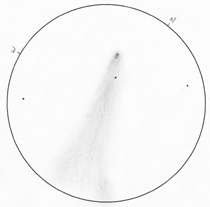 While observing Fragment C the night of April 18, I noted three stellarings within the coma. A review of professional and amateur images of this fragment made that night and since has failed to produce any evidence suggesting pronounced fragmentation of the nucleus. Tonight's 399X view in the Obsession is captured in the sketch at left. The head lies about 30" northeast of a 13th magnitude GSC star. A 15.6 (B) magnitude star lies 2'.5 to the northwest and just inside the field boundary. About 3'.6 to the southeast of the pseudonucleus, stands a 15.3 (B) magnitude star. Fragment C's pseudonucleus features a stellar core enmeshed within a bright inner coma. This coma is tiny, perhaps 15" by 10" in size and tear-shaped. The brightest portion of the tail sweeps southwest from the head, broadening and arcing further west a the field boundary. Similar to Fragment B, this fragment features a narrow, bright spine trailing behind the coma for a distance of several arcminutes.
While observing Fragment C the night of April 18, I noted three stellarings within the coma. A review of professional and amateur images of this fragment made that night and since has failed to produce any evidence suggesting pronounced fragmentation of the nucleus. Tonight's 399X view in the Obsession is captured in the sketch at left. The head lies about 30" northeast of a 13th magnitude GSC star. A 15.6 (B) magnitude star lies 2'.5 to the northwest and just inside the field boundary. About 3'.6 to the southeast of the pseudonucleus, stands a 15.3 (B) magnitude star. Fragment C's pseudonucleus features a stellar core enmeshed within a bright inner coma. This coma is tiny, perhaps 15" by 10" in size and tear-shaped. The brightest portion of the tail sweeps southwest from the head, broadening and arcing further west a the field boundary. Similar to Fragment B, this fragment features a narrow, bright spine trailing behind the coma for a distance of several arcminutes. |
![]()
![]()
